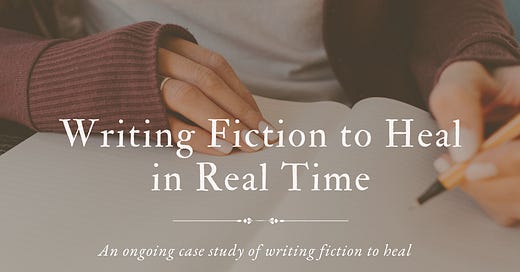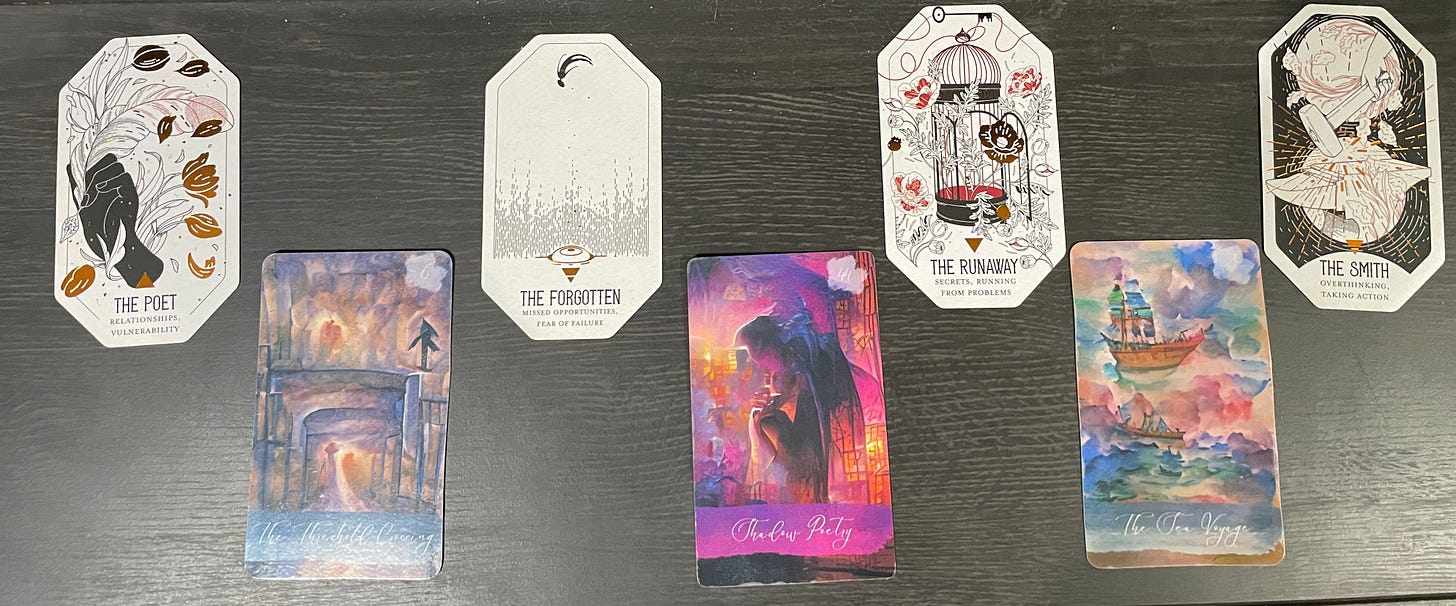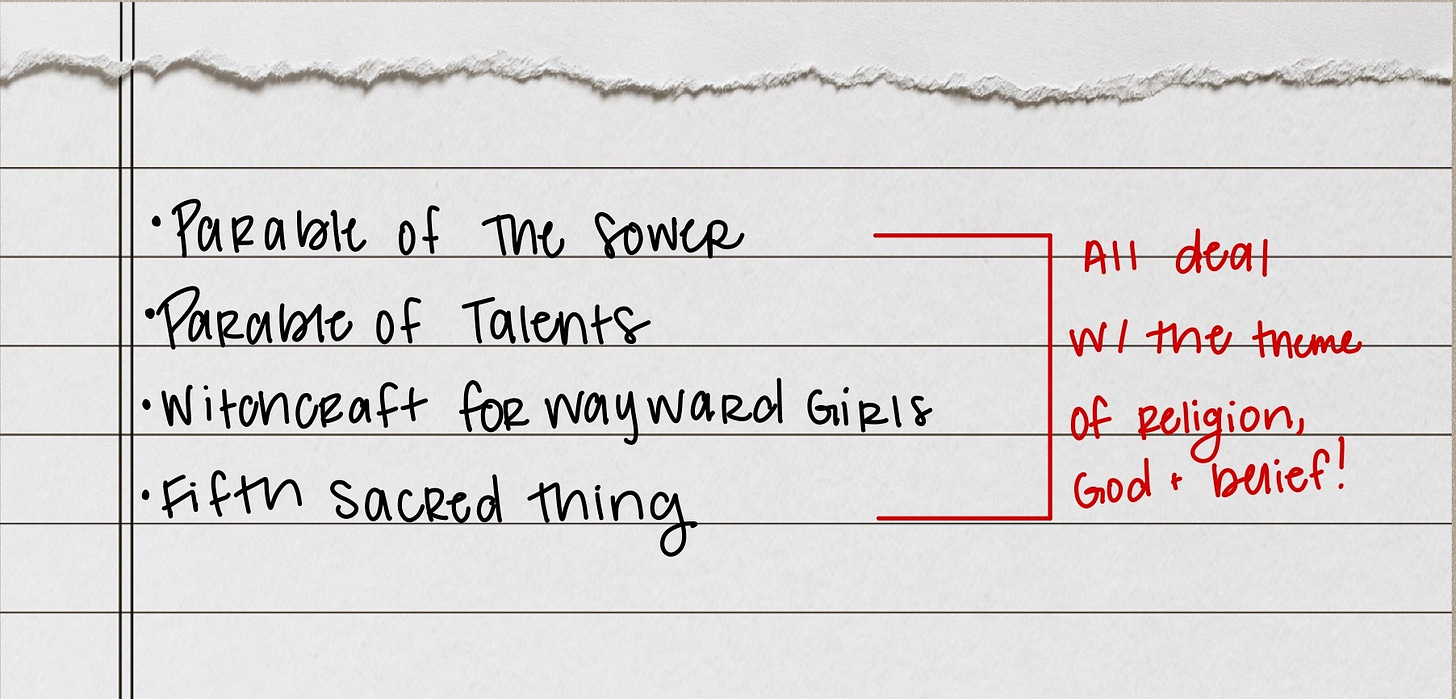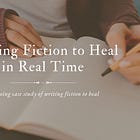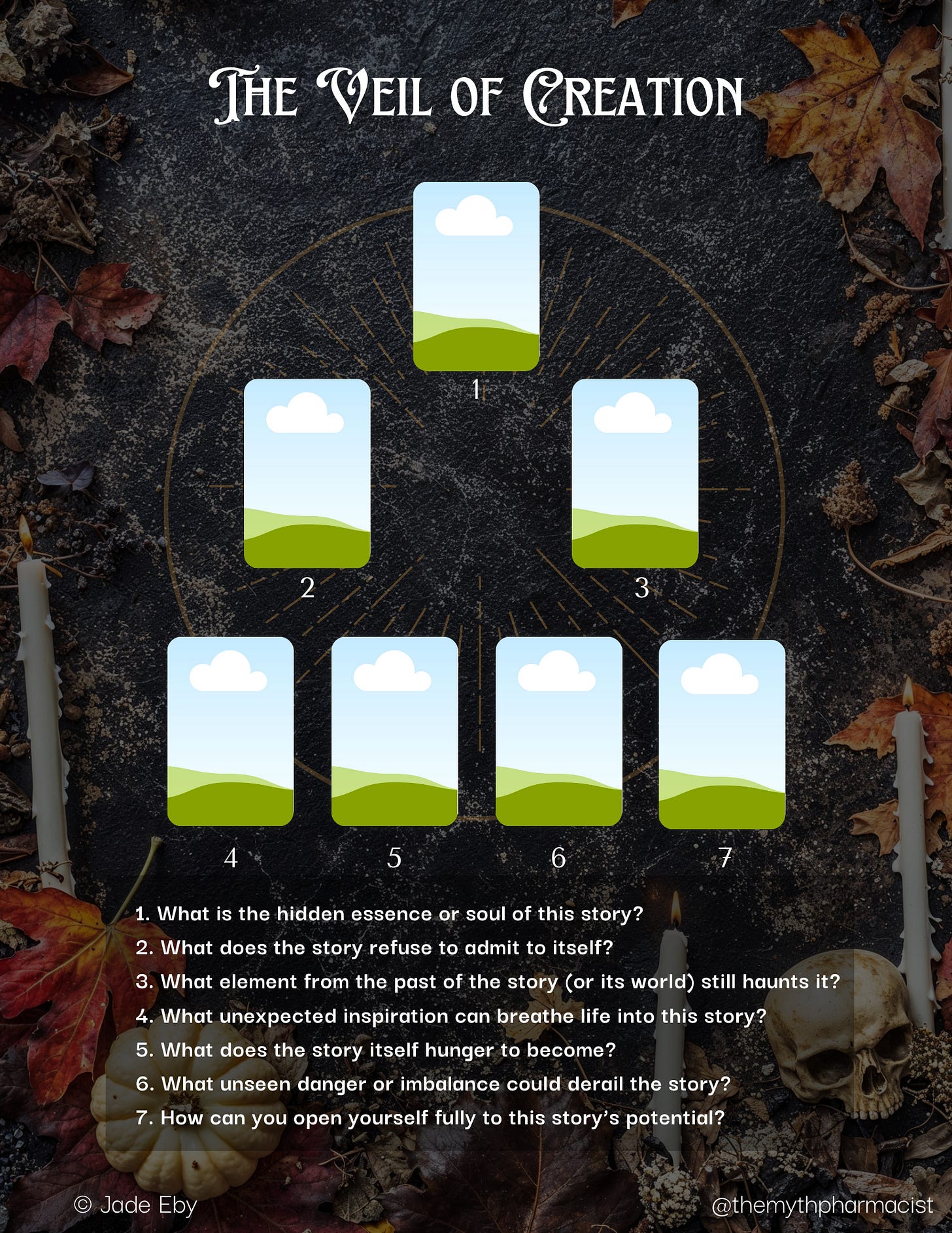If you’re new to The Rebel MFA Way, welcome! This is an essay in my ongoing “Writing Fiction to Heal in Real Time” series where I deep-dive into my writing fiction to heal method as field work and a case study. To begin, I will be working through my story, The Archive, which you can find more information on here.
[NOTE: Your email provider may truncate this essay, be sure to click on “keep reading” to read the entire piece.]
Let’s continue swimming…
Last week, I shared with you some ways that I swim with the “what-ifs” of a story in progress. There was just too much to share in one essay, so here is part two. We already talked about indulging, making book soundtracks, using active imagination, and interviewing characters. This week, we’ll go a little bit deeper.
Since publishing my first part of this essay, a few of you have sent in some really juicy and interesting questions. This is one reason I love writing these pieces so much — your questions and thoughts help me get even clearer on my own thoughts! A few are topics that really could span an entire essay or article (or maybe a podcast?) to answer but over the coming weeks, I’ll try to weave them into our conversations.
Until then, I present you with another list of ways I swim with my “what-ifs.”
iceberg diving.
I have a love/hate relationship with this technique because it’s often used in therapy, so it can feel a bit “clinical” but I actually think the correct word is: direct. It forces you to be very clear and direct in your answers to the questions it asks. And though the word be small… it is mighty.
Just like “No” is a powerful one-word sentence, “Why?” is a powerful one-word question.
The technique is simple but not easy. You ask yourself or your characters “why?”
Look how much information I got about the story, my character, what’s happening, how she feels, just with these 5 questions.
This is a great technique to use when you are stuck on a particular theme or moment in your story and you need to dig deeper to find the “why” beneath the surface.
roleplaying with ai.
One of my favorite creative ways to utilize/leverage Ai in an ethical way is the “roleplaying” functionality. By getting specific with the chatbot, I can play with it roleplaying as different characters or outside “readers.”
I was elated with the conversation I had with the “person who found Ari’s journals” in the future and the way it asked questions and responded so… thoughtfully?1
This particular conversation was done in Claude 3.5 Sonnet:



Ai can act as a curious reader, asking questions or pointing out inconsistencies, but also offer reassurances and reflect back to you what it is “seeing” from your story. In Entry #1, I intentionally did not explain why Ari decided not to take the Harry Potter books. And I love how this bot caught that and asked about it. It gave me an opportunity to get clear on why Ari (and me, if we’re honest) has such feelings for the series. This bot also asked me some really tough questions that I hadn’t even thought of and will be working to incorporate into the story as I go.
Another experiment made me cry a little bit as the chatbot role played as Finn (Ari’s dead husband in the story). This is from ChatGPT.

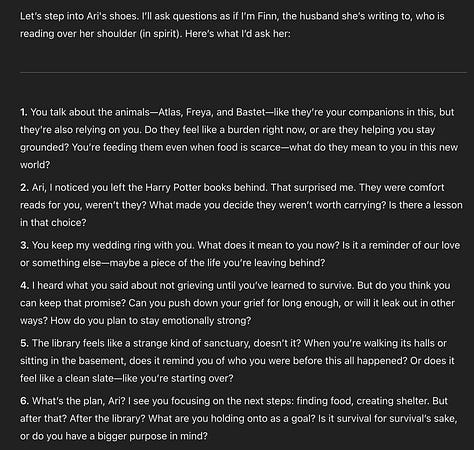
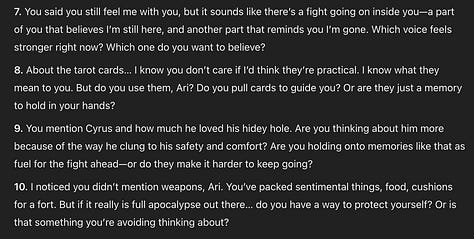


Roleplaying allows you to interact with your characters in real time, forcing them to respond dynamically to questions or scenarios you pose. This can reveal aspects of their personality, backstory, or motivations that you might not have consciously planned. And this interaction particularly felt resonate with Finn’s “side quips.”
using cards and spreads.
I’ve talked about using tarot and oracle cards for writing many, many times (like here, and here, and here) so I won’t spend too much time on this section. But I do want to touch on it, because I crafted some very specific spreads and cards to swim with the “what-ifs” for this story.
This is a seven card spread I crafted called “The Veil of Creation.”2 It’s meant to uncover the soul of the story and summon inspiration from the unseen and the subconscious. I was actually a little stunned when I sat down to compile my thoughts on this spread because there were some profound realizations. For example, the first card pulled was “The Poet” and it’s position asked, “What is the hidden essence or soul of this story?” It’s meant to represents the primal energy or archetype that drives the story on a spiritual or symbolic level. It’s the hidden current that runs beneath all surface-level details. Think of it as the story’s “shadow self.”
The part of the description for this card that stopped me cold was:
This is an isolated Poet; a Poet who has been so careful to protect their heart that no one knows who they truly are. But vulnerability isn’t something to be afraid of — rather, a sign of being alive, and of having things that are important enough to risk losing. Rather than letting yourself feel distanced and socially unsupported, it’s time to reach out, or to try and meet new people.
I realized that yes, while the surface level essence of Ari’s story is survival and resilience, the layer beneath is exactly this… her inability to trust others in the face of these dark times. She has isolated herself with her husband for so long that he was an extension of her. Now that he’s gone… she feels like there is no one she can ever trust again. Will that help or hurt her chances at survival?
Another illuminating card/position was #5, “The Runaway.” “What does the story itself hunger to become?” This position speaks to the potential or destiny of the story, what it seeks to grow into.
This description gave me chills:
It’s normal to want to run from your problems rather than facing them. But you’ll soon find that this won’t resolve anything; your problems will simply follow you until you’re overwhelmed by everything you’ve been avoiding. It’s time to start admitting to yourself what you’re running from and address it. What are you punishing yourself for? Why are you still carrying this guilt around? Let it go, and make sure that you’re living a life free from self-hatred.
Again, this speaks to both the surface level and deeper issues of Ari’s story. At some point, Ari is going to have to decide what to do with herself. Will she continue to fight and survive? Will she give up and let the world take her down? Will she lay down the guilt she feels about Finn’s death? How will she solve her problems?
Put all together, the seven cards in this spread gave me plenty to think about and helped me sit and swim with the “what-ifs” they brought up.
fictional comparisons.
This is one of my favorite ways to really deep-dive into my character because it brings so much clarity to the table. While I’m always comparing my characters in fiction to myself… sometimes it can be useful to compare them to other fictional characters. For this story in particular, I have found it extremely useful to sit with how my main character Ari is or isn’t like Lauren Oya Olamina from the Parable series and Maya Greenwood from The Fifth Sacred Thing.
By examining the traits or themes that these fictional characters have, it becomes much easier to see where your own character fits. In my example, you’ll see that I get pretty granular (except for a few traits) with who Ari is. This is all information that will help me develop her and the story as I go.
asking hard questions.
A large part of writing fiction to heal is about asking the hard questions and letting the story be the answer. That’s precisely how this story began to spiral into what it is. I was asked the question, “what is your greatest fear?” And this story is the answer.
It is not a coincidence (though it wasn’t intentional, either) that I ended up reading 4 books back to back that all deal with the theme of religion, God and belief systems. Granted, three of the four of these are post-apocalyptic-ish so that makes sense. But the other one felt like an outlier and still had a heavy theme of religion and God. Which got me turning circles on a question that I’ve had since I began this project. Do I believe in God? Does Ari?
The answer has always been a resounding no. But it’s more nuanced than that. You know that, I know that and Ari knows that. But it’s a fascinating topic that I think I can explore even more fully through Ari because of her situation. There’s nothing like faith and belief when the world is crashing down around you, right? But it’s not an easy question to answer and that’s what makes it so appealing to me (and hopefully, to readers!).
Another hard question… one that I’m actively struggling with in my own reality as well as in Ari’s is this question of legacy. What does legacy actually mean? And does it actually matter when the world is in collapse? What kind of legacy can someone realistically make for the future in this kind of world? Is legacy a tangible thing or abstract? There’s so many questions and possibilities to explore here! That’s why it’s a hard question and one I must write to answer.
I hope the examples from Part One and Part Two of swimming with “what-ifs” has helped you see just how expansive, wild and exciting it can be to sit with these aspects of your novel. I would much rather spend my time contemplating and working in this way than trying to retro-fit a plot structure for my character. I would much rather sit with these hard questions and how I’m going to figure them out than figure out where Ari needs to be at 25% of the book. And if you’ve ever felt like maybe you don’t want to do things the way “they’ve always been done,” then I hope this gives you permission to say “fuck it” and do it your own way.
Next time…
Next week, I’ll be diving into some of the writing fiction to heal exercises from the book to explore Ari’s backstory, something I’ve strangely not thought much about. I’ve been really focused on her “recent past” (pre-collapse) and her “now.” But there is SO much to be gained by digging into her childhood. That’s where we’re headed next.
Don’t want to get these email notifications? Or maybe you want to make sure you get these notifications? Manage your notification settings here:
To read the backstory to why I’m writing this series:
To read the backstory on why I’m serializing “The Archive,”:
This fills me with excitement and dread as far as the uses of technology goes


